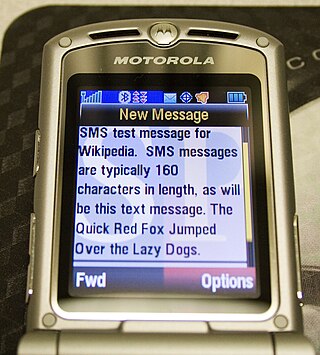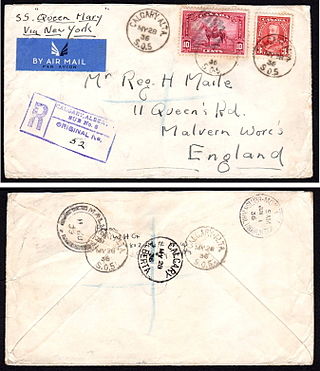Related Research Articles
The Internet Control Message Protocol (ICMP) is a supporting protocol in the Internet protocol suite. It is used by network devices, including routers, to send error messages and operational information indicating success or failure when communicating with another IP address, for example, an error is indicated when a requested service is not available or that a host or router could not be reached. ICMP differs from transport protocols such as TCP and UDP in that it is not typically used to exchange data between systems, nor is it regularly employed by end-user network applications.

Short Message/Messaging Service, commonly abbreviated as SMS, is a text messaging service component of most telephone, Internet and mobile device systems. It uses standardized communication protocols that let mobile devices exchange short text messages. An intermediary service can facilitate a text-to-voice conversion to be sent to landlines.

A teleprinter is an electromechanical device that can be used to send and receive typed messages through various communications channels, in both point-to-point and point-to-multipoint configurations. Initially they were used in telegraphy, which developed in the late 1830s and 1840s as the first use of electrical engineering, though teleprinters were not used for telegraphy until 1887 at the earliest. The machines were adapted to provide a user interface to early mainframe computers and minicomputers, sending typed data to the computer and printing the response. Some models could also be used to create punched tape for data storage and to read back such tape for local printing or transmission.
In telecommunication, an exempted addressee is an organization, activity, or person included in the collective address group of a message and deemed by the message originator as having no need for the information in the message.
Signalling System No. 7 (SS7) is a set of telephony signaling protocols developed in the 1970s, which is used to set up and tear down telephone calls in most parts of the world-wide public switched telephone network (PSTN). The protocol also performs number translation, local number portability, prepaid billing, Short Message Service (SMS), and other services.

Registered mail is a mail service offered by postal services in many countries which allows the sender proof of mailing via a mailing receipt and, upon request, electronic verification that an article was delivered or that a delivery attempt was made. Depending on the country, additional services may also be available, such as:

Onion routing is a technique for anonymous communication over a computer network. In an onion network, messages are encapsulated in layers of encryption, analogous to the layers of an onion. The encrypted data is transmitted through a series of network nodes called "onion routers," each of which "peels" away a single layer, revealing the data's next destination. When the final layer is decrypted, the message arrives at its destination. The sender remains anonymous because each intermediary knows only the location of the immediately preceding and following nodes. While onion routing provides a high level of security and anonymity, there are methods to break the anonymity of this technique, such as timing analysis.
The Aeronautical Fixed Telecommunications Network (AFTN) is a worldwide system of aeronautical fixed circuits provided, as part of the Aeronautical Fixed Service, for the exchange of messages and/or digital data between aeronautical fixed stations having the same or compatible communications characteristics. AFTN comprises aviation entities including: ANS providers, aviation service providers, airport authorities and government agencies, to name a few. It exchanges vital information for aircraft operations such as distress messages, urgency messages, flight safety messages, meteorological messages, flight regularity messages and aeronautical administrative messages.
Message precedence is an indicator attached to a message indicating its level of urgency, and used in the exchange of radiograms in radiotelegraph and radiotelephony procedures. Email header fields can also provide a precedence flag.
Network performance refers to measures of service quality of a network as seen by the customer.

The posting rule is an exception to the general rule of contract law in common law countries that acceptance of an offer takes place when communicated. Under the posting rule, that acceptance takes effect when a letter is posted ; the post office will be the universal service provider, such as the UK's Royal Mail, the Australia Post, or the United States Postal Service. In plain English, the "meeting of the minds" necessary to contract formation occurs at the exact moment word of acceptance is sent via post by the person accepting it, rather than when that acceptance is received by the person who offered the contract.
Decoding, in semiotics, is the process of interpreting a message sent by an addresser (sender) to an addressee (receiver). The complementary process – creating a message for transmission to an addressee – is called encoding.
Emailtracking is a method for monitoring whether the email message is read by the intended recipient. Most tracking technologies use some form of digitally time-stamped record to reveal the exact time and date when an email is received or opened, as well as the IP address of the recipient.

Radioman (RM) was a rating for United States Navy and United States Coast Guard enlisted personnel, specializing in communications technology.

Telex is a telecommunication service that provides text-based message exchange over the circuits of the public switched telephone network or by private lines. The technology operates on switched station-to-station basis with teleprinter devices at the receiving and sending locations. Telex was a major method of sending written messages electronically between businesses in the post–World War II period. Its usage went into decline as the fax machine grew in popularity in the 1980s.
A call detail record (CDR) is a data record produced by a telephone exchange or other telecommunications equipment that documents the details of a telephone call or other telecommunications transactions that passes through that facility or device. The record contains various attributes of the call, such as time, duration, completion status, source number, and destination number. It is the automated equivalent of the paper toll tickets that were written and timed by operators for long-distance calls in a manual telephone exchange.
In data networking, telecommunications, and computer buses, an acknowledgment (ACK) is a signal that is passed between communicating processes, computers, or devices to signify acknowledgment, or receipt of message, as part of a communications protocol. The negative-acknowledgement is a signal that is sent to reject a previously received message or to indicate some kind of error. Acknowledgments and negative acknowledgments inform a sender of the receiver's state so that it can adjust its own state accordingly.
The European Academic and Research Network (EARN) was a computer network connecting universities and research institutions across Europe, and was connected in 1983 via transatlantic circuits and a gateway funded by IBM to BITNET, its peer in the United States.
The United Nations Convention on the Use of Electronic Communications in International Contracts is a treaty that aims at facilitating the use of electronic communications in international trade. It was prepared by the United Nations Commission on International Trade Law (UNCITRAL) and adopted by the United Nations General Assembly on 23 November 2005. Pursuant to Article 23, it entered into force on 1 March 2013, the first day of the month after six months passed following adoption by three States parties, namely the Dominican Republic, Honduras, and Singapore.

An ARRL radiogram is an instance of formal written message traffic routed by a network of amateur radio operators through traffic nets, called the National Traffic System (NTS).
References
 This article incorporates public domain material from Federal Standard 1037C. General Services Administration. Archived from the original on 2022-01-22. (in support of MIL-STD-188).
This article incorporates public domain material from Federal Standard 1037C. General Services Administration. Archived from the original on 2022-01-22. (in support of MIL-STD-188).